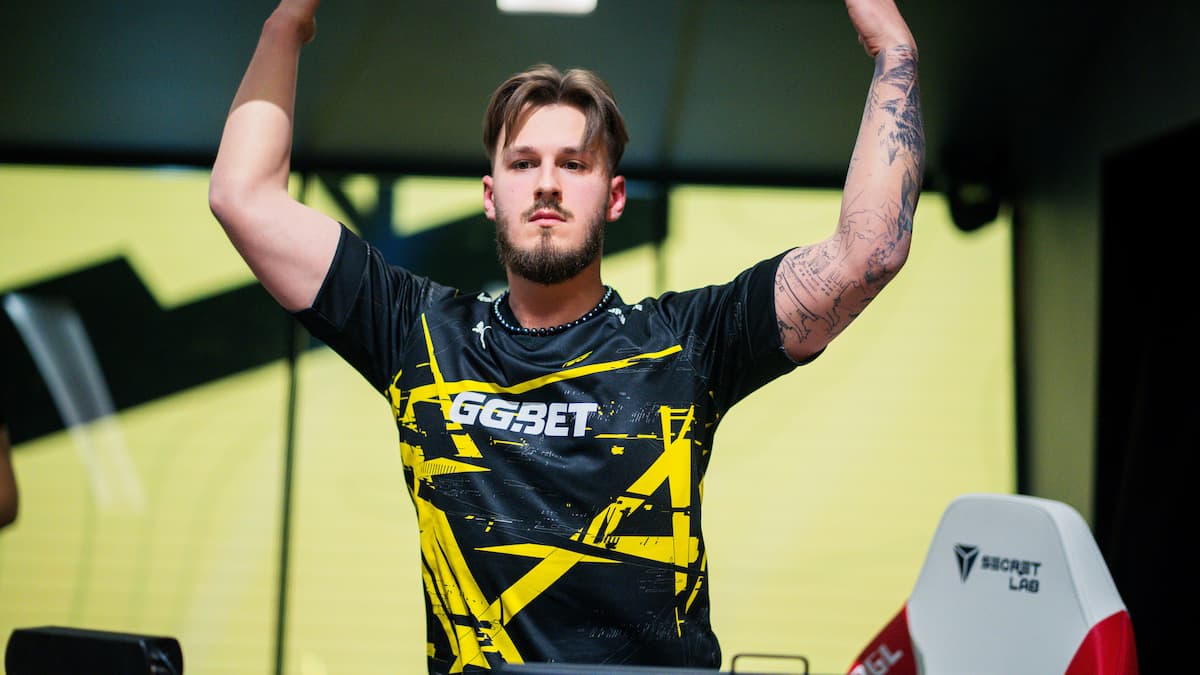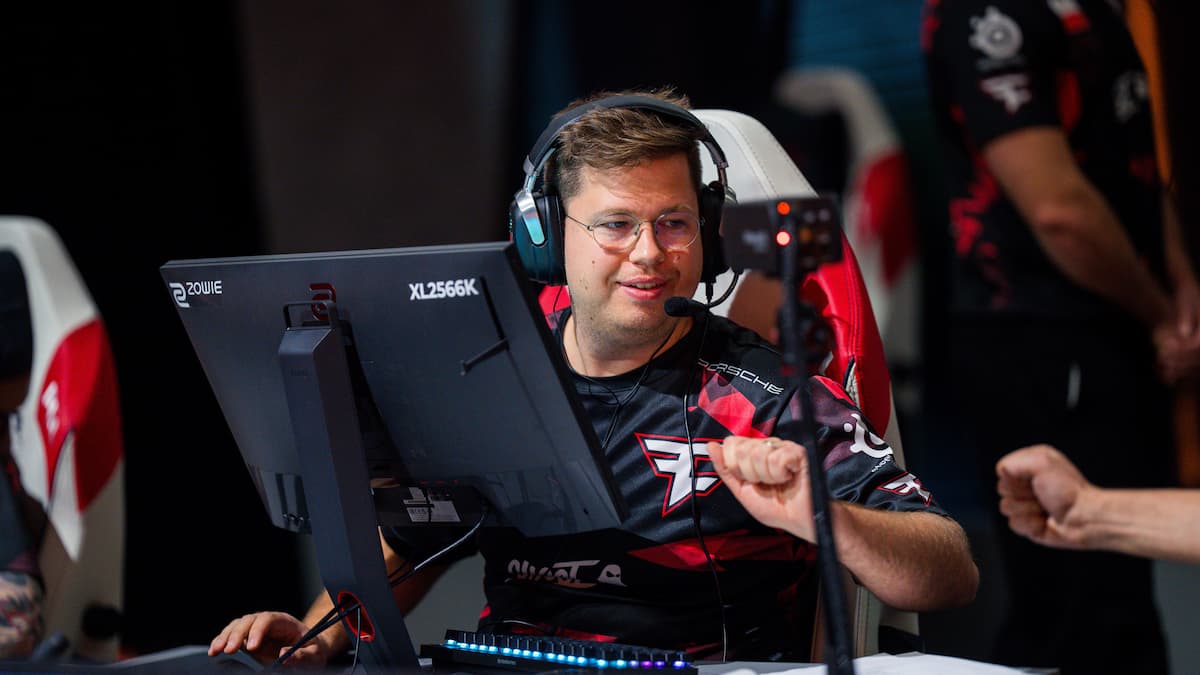Simon “smn” Beck’s ban from ESEA has caused reverberations around the Counter-Strike scene. Beck is one of of the few guilty parties who hasn’t protested his innocence. Instead, he said that, in his opinion, as high as 30 percent of the professional scene were cheating—and then he also reeled off a list of well-known names he claimed were guilty.
Shortly after, two of France’s leading players, Hovik “KQLY” Tovmassian and Gordon ‘Sf’ Giry, were banned by Valve’s anti-cheating software, VAC. The community waited for more of the dominoes to fall.
The cheat became redundant. It died out. Its most potent weapon had been its secrecy.
So far, that hasn’t happened. The world’s top players have traveled to DreamHack Winter, a major event with $250,000 up for grabs, under a cloud of suspicion. You can’t understate the prevailing sense of shock. Players have turned on their fellow professionals. And the fans seem to be in disbelief that their Counter-Strike idols would cheat.
This reaction is incredible. You only have to look at the game’s history to know that many cheaters have resided in Counter-Strike’s upper echelons. The professional players have the most to gain. They’re the ones most likely to succumb to temptation. A falsely obtained rank in matchmaking is one thing; a share of $100,000 and merchandising profits per major tournament is another.
No one should be shocked. Yes, this is the largest scandal to ever hit the scene. But it was one the scene had long been moving towards, and which no one did anything to halt.
Counter-Strike: Source had warning signs dotted throughout the game’s development, hinting that cheating was becoming increasingly common among top ranked competitors—even at LAN. Sadly, due to the elitist divide between the 1.6 and Source scenes, most of that history has been forgotten or isn’t even known to the new generation of Global Offensive fans.
As the Source scene became more lucrative, cheats no longer targeted the average player. While there was money to be made in subscription cheats that could bypass VAC detection, there was even more to be gained in marketing LAN-specific cheats to professional and semi-professional players.
In 2009 I leaked one of the most notorious cheats at the time, vent.exe, into the public domain. It’s name was designed to cloak it as part of the voice chat program Ventrilo. It was only 170kb in size, so small it could be easily transported in a flash drive or even the memory of a gaming peripheral.
The cheat was a very simple aimbot with such a low field of view that it was imperceptible to the human eye in real time. Players could toggle it on with numlock, then set it to either snap to head or to chest, but only from a close enough distance. In short, if you were not quite perfect, this would get you the rest of the way. The cheat originated in the Benelux scene, where several players would use it at the smaller, local LANs. Its creator had only ever wanted it to be used by a handful of people. Slowly but surely, however, more and more people shared it.
Vent.exe became a buzzword for cheating. No one was safe from accusations. Just ask Ladislav “GuardiaN” Kovács. In a year when he became one of the greatest AWPers the game had ever seen, he was plagued with accusations—even though the dragshots and doorbangs that made him an unstoppable force couldn’t be attributed to how the cheat worked.
After leveraging a relationship with a cheat coder, I sent a copy to several anti-cheat coders and, in turn, Valve itself. Then I wrote an article about it, with input from the cheating community, and sat back and watched what happened.
Cheaters should not get to control the narrative in the absence of the truth.
With the lid lifted on the cheat, everyone wanted a copy. I was approached by dozens of top-ranked players who asked for it for “experimental purposes.” For a few weeks, it seemed like everyone was using it. I was criticized by many figureheads in the scene. But in the end, the cheat started triggering VAC bans. And admins I had worked with even started checking the PCS of suspect players at several events.
The cheat became redundant. It died out. Its most potent weapon had been its secrecy.
To me, this proved that the best way to beat cheating was to talk about it openly, to not be prudish about questioning high level players who ultimately have the most to gain from using cheats.
This might sound like I’m calling for a witch-hunt. I’m not. I agree with some of my colleagues who have warned against slinging shit at people without due cause. This is absolutely correct. By the same token though, I also know first-hand that whenever a new cheat or exploit is available you can be absolutely sure that professionals will be among the first to know about it and “test” it. It’s in their best interests to know every facet of the game. That is why people download pro player configs. We expect them to have the commands for optimum performance. So, if there is indeed a command that tweaks the game, to confer an advantage, you can be sure most pros will know about it. And a significant percentage will also be using it.
Let me place this in context. When I first started writing about Counter-Strike, I knew many of the top players, especially those from the U.K. Though I wasn’t in their skill bracket, they’d still invite me to play with them. I soon learned several commands that made the game easier, as well as how to exploit game rates and interpolate to my advantage.
Seeing me as a liability, several players told me how to alter in-game files to create see-through boxes, see through-walls, using a video shader glitch that was referred to as “the pink walls” bug. It was essentially a partial wallhack that would never trigger a VAC ban and would only be detected by anti-cheat software that took screenshots. Each time I was told not to tell anyone. I’d play dumb each time a new source showed me. Clearly, among the best players at least, it was an open secret.
The lid got blown off the bug one when one of the U.K.’s best players on the U.K.’s best team, David “jaFro” Davidson of Zboard, accidentally uploaded a screenshot of the cheat in action. He was given a month ban. He’d later be VAC banned in what was the first major cheating scandal I got to report on. He stated that a friend had cheated on his account after he had left it logged in round a friend’s house. While there were consequences—he was banned from competing in the eBuyer tournament at i30, the largest Source competition in Europe at that time—it still didn’t prevent him from competing in the U.K. Championship Gaming Series qualifier to become a salaried professional player in a televised league.
There was plenty of controversy at that i30 event. I was in attendance and saw several players using two bugs at the LAN. The first was a command that made the game’s sound files show up in the top corner of the screen. This meant, for example on a map like nuke, you could be on the other side of the map, well out of earshot, and yet if your opponent was opening the blue squeaky door, the line “playing door.wav” would show on your screen. It was a bug that was only useful in limited situations. But it was undoubtedly an advantage.
A more famous bug allowed you to avoid the effects of flash bangs by Alt+Tabbing out of the game. This was used by many teams at the event. I witnessed the German team mTw use it, as well as several of the aspiring U.K. teams whose names have faded into obscurity. The bug’s origins came from the German league and had been circulated round the top European teams. It became well known after the German Team Alternate Attax were disqualified from the SHG Open 2007 two months prior to i30. For the rest of the year the team were dubbed “Alt Tab Attax” by fans.
After that, something called “consistency bypasses” became popular—in layman’s terms, this means being able to change in-game textures to custom ones with different properties (for example, making solid brick walls appear as if they are made from glass and therefore transparent). These were distributed among top-level players. Had it not been for the Zblock team and help from Valve themselves, as well as the proliferation of screenshot taking anti-cheats, then wallhacking would have seen widespread adoption.
In 2010, the update to the Orange Box engine meant that if you used different DirectX versions—dxlevel95 as opposed to dxlevel81—flashbangs were less effective. This caused arguments in the competitive scene that raged to no end, as almost every top team exploited this bug. Even the dominant team at the time, the French powerhouse VeryGames, were accused of using it. Amid an air of distrust, it shortly became a requirement that the dxlevel was set to 81 as standard, with configs monitored to make sure that everyone was toeing the line.
Not long after, several top ranked players noticed that if you looked at the “in: xx x.xx k/s” value, the number would rise whenever an opponent approached your position. This made it possible for players to make early calls for their team if people were grouping up on the other side of a wall, and made 1-v-1 clutches for the players using it a lot easier too. One of the U.K.’s most successful captains, Sam “RattlesnK” Gawn, publicly accused VeryGames of using this bug online and at LAN events, prompting an official statement from the team manager.
Finally, there was the ambient occlusion bug, a way to see through smoke in the game. The high profile player caught using this cheat was Jacob “Pimp” Winneche. It showed up in a screenshot taken while he was playing in an online cup for prize money. He was pilloried by many of his fellow professionals. But the reality is many of those same critical voices were using it also.
See a pattern?
The truth is that the high-level Counter-Strike scene has always been awash with players using anything they can to get a competitive edge. Why so many of these are in-game exploits as opposed to third party software should be clear: The specter of Valve’s Anti Cheat and the stigma attached to a VAC ban mean most pros won’t take the risk. Remove that from the equation and things change. My advice based on my many years of interacting with pros is to beware of anyone saying something like “I wouldn’t even know how to install a cheat.”
Of course, sometimes professional players just download cheats because they feel they are above reproach by past excellence.
The competitive integrity of the game demands clarity of information.
I’ve known many players who used to cheat in practice and casual games claiming they don’t see why they should have to “try hard” outside of competition, especially after they’ve proven themselves many times over. Other times it’s to get back at lesser players who they feel must be cheating against them, as happened when two of North America’s most iconic players Yazan “clowN” Ammari and Sam “devour” Chamma, decided to cheat in the CEVO Alienware Winter Frag Fest against the dubious Andrew “Glockateer” Cook. In the resulting aftermath, and their ban from CEVO, they stated that they weren’t sorry and would have done it again.
Despite this and many more examples, there seems to be some prevailing sentiment that the high end of Counter-Strike is entirely honest. People are declaring teams cheat-free, not even aware that some of those teams’ have been banned by anti-cheat software and, in some cases, VAC in other iterations of the game.
LAN has always been the proving ground for Counter-Strike players of all levels. One good LAN performance and you can pull out infinite amounts of bullshit online without anyone batting an eyelid. This has been so blindly accepted as a truth that tournament organizers have rested on their laurels.
Players travel to events, set up their equipment without any scrutiny, idly using their phone between installing drivers, pulling out flash drives and uploading configs without any challenge. Many admins, seemingly overawed by being in the presence of these stars, grovel and tell the professionals they can take their time, then hand over the RCON password so they can start the game themselves. The matches are played out with only managers and/or coaches standing behind the players. After all, this is LAN. What could be going on?
The most dangerous thing to the lifespan of an esport is when the competition becomes meaningless.
Both the manufacturers of cheats and the professionals who use them have identified this opportunity and exploited it for profit. At this stage, it’s hard to place faith in any of the most recent occurrences as being “legitimate.” We just can’t be sure about anything. It’s only fair to give players the benefit of the doubt. But the fact is, there’s a glut of circumstantial evidence pointing to several other players doing things that simply cannot be logically explained away as chance occurrences.
Will anyone care once they’ve had their fill of drama? How many people out there exploiting the spike in traffic really think about the integrity of the game?
To me, one of the main problems hasn’t been that the community engage in witch-hunts. Rather, it’s that they’re often too forgiving. When players are banned by leagues the community turn on those issuing the penalty, as we saw with ESL’s ban of Jerry “xelos” Råberg. People said then that we had to trust the anti-cheat software, not the human eye, and as such couldn’t issue a ban. However, when people are banned due to anti-cheat software flagging up an infraction, such as it did with current Virtus Pro player Janusz “Snax” Pogorzelski in 2011, the community then point out that the software is “ineffective” and can’t be trusted.
That point was illustrated effectively when Danish player Emil “zaider” Brandt was not only banned by ESL Wire but also had a screenshot on his Easy Anti-Cheat profile with a known EAC bypass on the desktop in the same month. Again, there were people in the community pointing out the flaws in the software, even as Danish event organizers issued a ban from all events in their country.
So, it seems, the community would like to place their faith in VAC. Yet, whenever a VAC ban does materialize, even when it’s in the most hilarious of circumstances—like Joel “emilio” Mako getting banned mid-tournament live on stream—all it takes is the guilty party to claim their account was hacked, or a friend did it, and it seems people come out in their droves to support them.
In my experience, the majority of Counter-Strike fans not only want to believe that even second-tier players whose name they know are clean, but when found guilty they generally have no issues with second chances.
For further proof, go view Emilio’s Facebook page and the outpouring of support after his most implausible explanation. Even his self-pitying retirement from the game didn’t last long. He’s back streaming and indirectly profiting from his reputation, pulling in the rubberneckers in the same way serial cheater Jonathan “FODDER” Reynolds does.
We need some big changes, and they have to start with those running the competitions. For years the temporary confiscation of phones has been par for the course in StarCraft and League of Legends tournaments. Referees stand behind competitors. PCs are monitored and snapshots of competitor’s set-ups taken so they can be checked should any allegations be made. Demo footage that can only be explained by something untoward needs to stop being treated as meaningless.
We also need Valve to break its silence around VAC bans. This is a stance that traditionally has been utilized to ensure that VAC catches people in waves; delayed bans and measured silence mean a cheat only becomes compromised when it is too late for the majority who used it to avoid being banned. This is a great strategy for Joe Public. But the community needs to know the reality where the professional players are concerned.
This proved that the best way to beat cheating was to talk about it openly.
A league commissioner, or some other arbitrary title, needs to be appointed—someone who can communicate the validity of VAC bans, telling tournament organizers and the public the dates the cheat was used so we know once and for all who did what. I, for one, am sick of every cheater saying they “tried it once and got VAC’d” because that is almost never the case. The competitive integrity of the game demands clarity of information; the cheaters should not get to control the narrative in the absence of the truth.
Finally the community needs to wake up and realize this has been a long time coming. And we are not even close to getting on top of this situation. I have been heartened by the response from the fans who have rightfully questioned everything that has been said and have not let this die down. It shows that maybe we are ready to tackle this problem head on. If we don’t, this growth period of Counter-Strike could end up being a short-lived aberration.
The most dangerous thing to the lifespan of an esport is when the competition becomes meaningless.
Illustration by Max Fleishman






Published: Nov 28, 2014 10:26 am